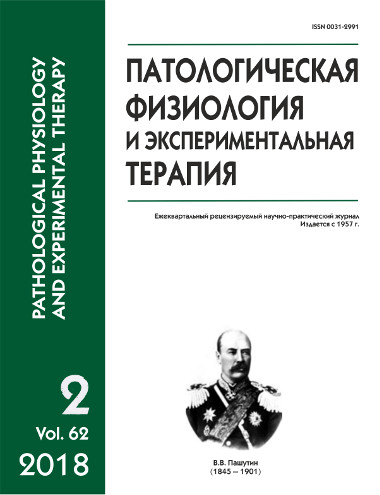A translational model of chronic heart failure in rats
DOI:
https://doi.org/10.25557/0031-2991.2018.02.136-148Keywords:
translational model, rats, chronic heart failure, echocardiography, morphology, brain natriuretic peptide, receptor expressionAbstract
Aim. Development of a translational model for chronic heart failure (CHF) in rats to identify new biotargets for finding and studying mechanisms of innovative drug effect in this disease. Methods. A set of echocardiographic, morphological, biochemical, and molecular methods was used to evaluate and differentiate stages of CHF development. Results. Dynamic echocardiographic studies showed that CHF developed in 90 days after anterior transmural myocardial infarction. By that time, left ventricular ejection fraction was significantly decreased in animals of the main group compared with rats studied on day 2 after experimental myocardial infarction (55.9±1.4% vs. 63.9±1.6%, respectively, p<0.0008). The decrease in heart’s pumping function (by 13% compared with day 2 after infarction and by approximately 40% compared to intact animals) was associated with increased ESD and EDD (from 2.49 ± 0.08 to 3.91 ± 0.17 mm, p = 0.0002, and from 3.56 ± 0.11 to 5.20 ± 0.19 mm, respectively, p=0.0001); therefore, dilated heart failure developed by that time. The results of echocardiographic studies were confirmed by myocardial morphometry, which demonstrated dilatation of both right and left ventricles. Paralleled histological studies indicated presence of the changes pathognomonic for this myocardial pathology (postinfarction cardiosclerosis, compensatory hypertrophy of cardiomyocytes, foci of disappeared transverse striation of muscle fibers, etc.) and signs of venous congestion in lungs and liver. Biochemical studies demonstrated a significant increase in plasma concentration of brain natriuretic peptide, a biochemical marker of CHF. Results of molecular studies suggested hyperactivity of the renin-angiotensin-aldosterone and sympathoadrenal systems, which play a key role in the pathogenesis of CHF. Conclusions. A translational model of CHF in rats was developed, which reproduced major clinical and diagnostic criteria for this disease. Morphometric, histological, biochemical, and molecular markers for progressive CHF were correlated with echocardiographic diagnostic signs, which allows using this echocardiographic, noninvasive method characterizing the intracardiac hemodynamics as a major criterion for the presence / absence of this pathology.Downloads
Published
2018-06-04
Issue
Section
Methods
How to Cite
[1]
2018. A translational model of chronic heart failure in rats. Patologicheskaya Fiziologiya i Eksperimental’naya Terapiya (Pathological physiology and experimental therapy). 62, 2 (Jun. 2018), 136–148. DOI:https://doi.org/10.25557/0031-2991.2018.02.136-148.






